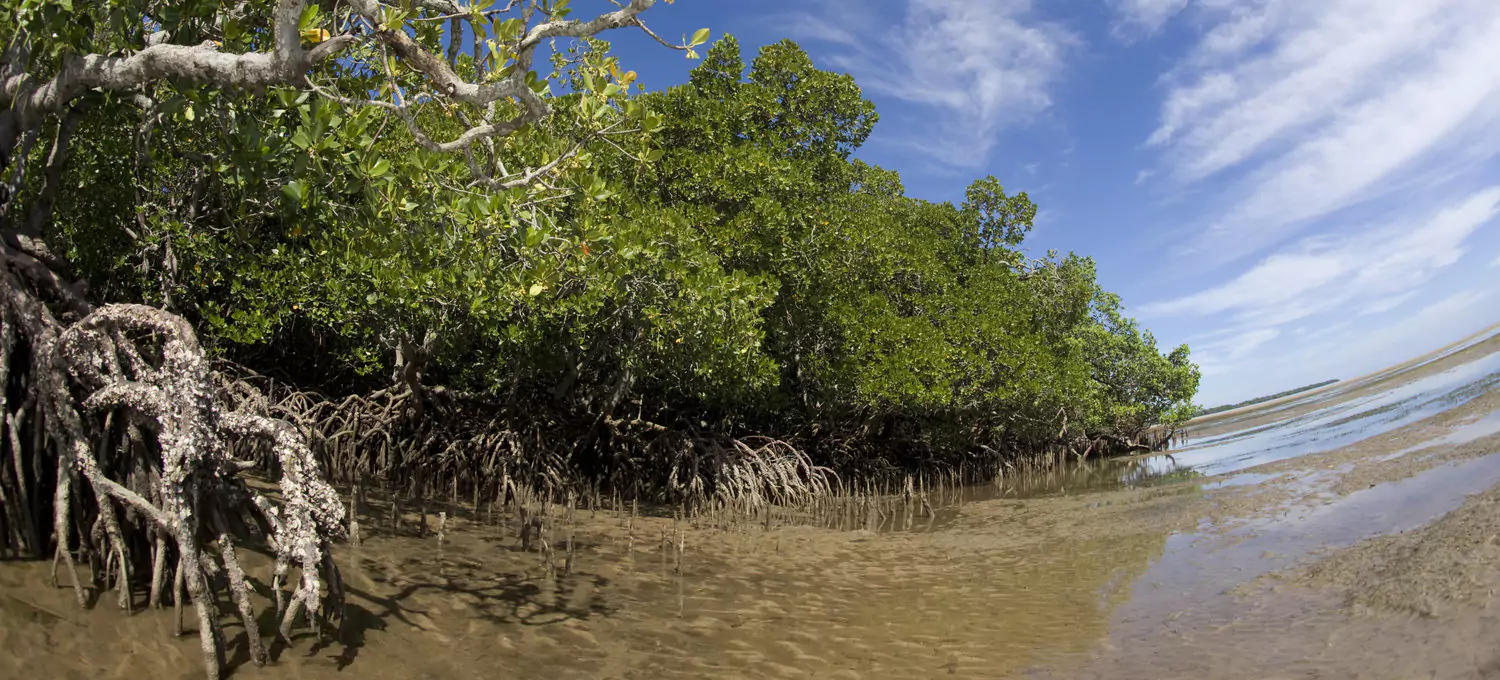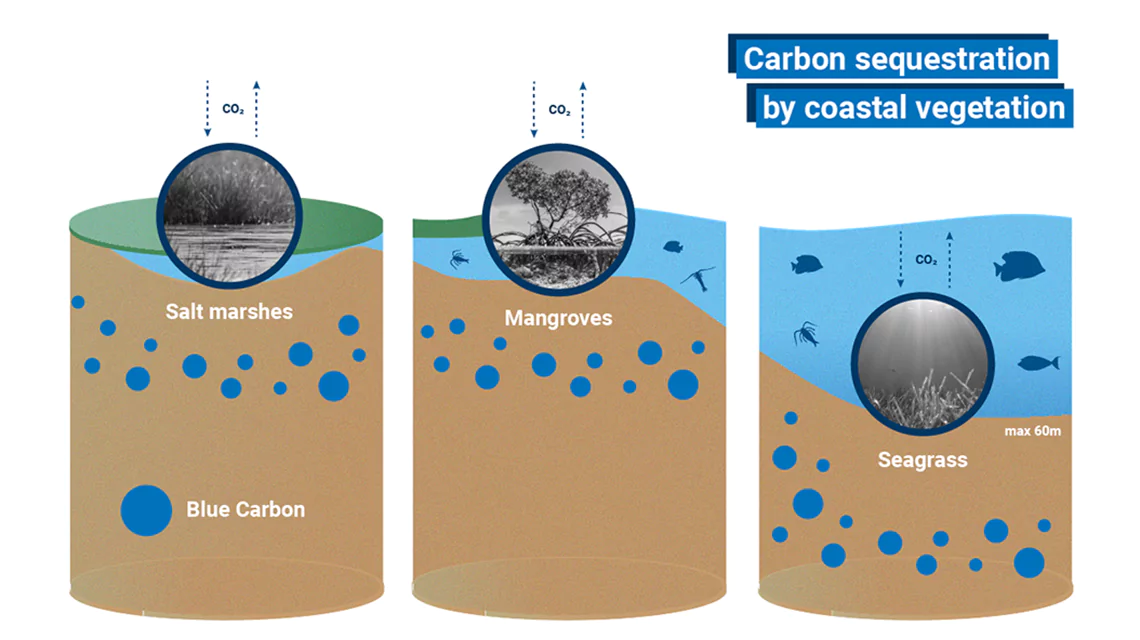Blue Carbon: An Overview
Blue carbon refers to the carbon captured and stored by coastal and marine ecosystems such as mangroves, seagrasses, and salt marshes. These ecosystems play a crucial role in mitigating climate change as they sequester carbon more effectively than terrestrial forests. Blue carbon is gaining global recognition for its role in carbon sequestration and climate change adaptation.
Significance of Blue Carbon Ecosystems
Blue carbon ecosystems—including mangroves, seagrasses, and salt marshes—offer multiple environmental, economic, and social benefits. They are some of the most productive and valuable ecosystems on Earth, playing a crucial role in climate change mitigation, biodiversity conservation, and coastal protection.
Carbon Sequestration: A Powerful Climate Solution
Superior Carbon Storage Capacity
- Coastal ecosystems store 3 to 5 times more carbon per equivalent area than tropical forests.
- Mangroves alone can store over 1,000 tons of carbon per hectare, making them one of the most efficient carbon sinks in the world.
How Blue Carbon Ecosystems Sequester Carbon
- Atmospheric Carbon Absorption:
- Through photosynthesis, mangroves, seagrasses, and salt marshes absorb CO₂ from the atmosphere.
- Long-Term Storage in Sediments:
- Unlike terrestrial forests, which store carbon in leaves and wood, blue carbon ecosystems trap organic carbon in waterlogged soils.
- These sediments can lock away carbon for centuries to millennia, preventing its release into the atmosphere.
- Peat Formation:
- Over time, plant material accumulates in layers, forming peat deposits, further enhancing carbon sequestration.
Threats to Carbon Storage
- Mangrove deforestation and degradation release carbon back into the atmosphere, contributing to global warming.
- Coastal development, agriculture, and aquaculture expansion destroy these ecosystems, reducing their carbon sequestration potential.
Global Impact:
If just 10% of degraded mangroves were restored worldwide, it could sequester an additional 1.6 billion tons of carbon, making restoration a high-priority climate action.
Biodiversity Conservation: Essential for Marine Life
Mangroves as Breeding and Nursery Grounds
- Nurseries for Young Marine Species:
- The dense root structures of mangroves protect juvenile fish, crustaceans, and shellfish from predators.
- Many commercially valuable fish species, including snappers, groupers, and shrimps, depend on mangrove nurseries.
- Habitat for Endangered Species:
- Mangroves support species such as the saltwater crocodile, Bengal tiger (Sundarbans), and dugong.
- Migratory Bird Habitat:
- Seagrass beds and coastal wetlands provide resting and feeding grounds for millions of migratory birds.
Support for Global Fisheries and Marine Food Chains
- Over 75% of tropical commercial fish species rely on mangroves, seagrass meadows, or coral reefs at some stage in their life cycle.
- Seagrass meadows, known as the "lungs of the sea," produce oxygen while supporting diverse marine organisms, including sea turtles and manatees.
- Salt marshes provide breeding grounds for shellfish and crustaceans.
Biodiversity at Risk
- 50% of the world’s mangroves have been lost since 1950 due to deforestation, coastal development, and pollution.
- Loss of blue carbon ecosystems leads to a decline in fish stocks and marine biodiversity, affecting global seafood supplies.
Coastal Protection: Natural Shields Against Disasters
Erosion Prevention and Shoreline Stabilization
- Mangrove roots stabilize coastal soils, reducing erosion caused by waves and tides.
- Seagrass meadows bind sediments, preventing seabed erosion.
Protection Against Storm Surges and Tsunamis
- Mangroves act as natural buffers, absorbing wave energy and reducing the impact of storms and cyclones.
- Studies show that a 100-meter-wide mangrove forest can reduce wave height by 66% before waves reach the shore.
- Countries like Bangladesh, the Philippines, and Indonesia rely on mangroves to reduce damage from typhoons and coastal flooding.
Climate Resilience for Coastal Communities
- Blue carbon ecosystems help mitigate sea-level rise by trapping sediments and maintaining coastline integrity.
- Salt marshes and mangroves help filter pollutants, improving water quality and making coastal areas more resilient to climate change.
Economic Benefits: Supporting Sustainable Livelihoods
Eco-Tourism and Recreation
- Mangrove forests, coral reefs, and seagrass meadows attract
eco-tourism activities such as:
- Kayaking, birdwatching, and snorkeling (e.g., the Sundarbans in India & Bangladesh).
- Diving and wildlife tours (e.g., the Great Barrier Reef, Australia).
- Sustainable tourism generates local income while promoting conservation.
Fisheries and Aquaculture
- Mangrove-associated fisheries contribute millions of dollars annually to coastal economies.
- Sustainable aquaculture—such as oyster and seaweed farming—thrives in these ecosystems.
Job Creation and Livelihood Security
- Restoration of blue carbon ecosystems creates jobs in:
- Conservation and reforestation projects (e.g., Indonesia’s MERA Program).
- Sustainable fisheries and mariculture.
- Carbon credit markets (e.g., Australia’s Blue Carbon Method).
Economic Value of Conservation
- According to the OECD (2024), every $1 invested in blue carbon restoration yields up to $6 in economic returns.
- The global market potential for blue carbon credits is projected to reach $50 billion by 2030 (McKinsey Sustainability).
Blue carbon ecosystems&Challenges
Blue carbon ecosystems, which include mangroves, seagrasses, and salt marshes, are among the most efficient natural systems for carbon sequestration, biodiversity conservation, coastal protection, and economic development. Understanding their significance helps in formulating strategies for conservation and sustainable management.
Carbon Sequestration: The Role of Coastal Ecosystems in Climate Change Mitigation
Coastal ecosystems play a crucial role in mitigating climate change by capturing and storing atmospheric carbon dioxide (CO₂). These ecosystems function as carbon sinks, meaning they absorb more CO₂ than they release, helping to reduce greenhouse gas levels in the atmosphere.
Key Facts:
- High Carbon Storage Capacity:
- Coastal ecosystems store 3 to 5 times more carbon per equivalent area than tropical forests.
- Mangroves alone can store over 1,000 tons of carbon per hectare, which is significantly higher than most terrestrial forests.
- Efficient Long-Term Storage:
- Unlike terrestrial forests, which store carbon primarily in biomass, blue carbon ecosystems store most of their carbon in deep, waterlogged soils.
- These sediments can lock away carbon for thousands of years, preventing its release into the atmosphere.
- Impact on Global Emissions Reduction:
- The destruction of these ecosystems results in carbon release back into the atmosphere, contributing to climate change.
- Restoring degraded mangrove forests worldwide could sequester an additional 6 billion tons of carbon.
Scientific Importance:
- Seagrass meadows capture carbon at a rate of 35 times faster than Amazonian rainforests.
- Mangroves prevent 25 million tons of CO₂ emissions annually by protecting stored carbon in coastal soils.
Biodiversity Conservation: Preserving Marine Life
Blue carbon ecosystems provide critical habitats for a diverse range of marine species and contribute significantly to marine biodiversity.
Key Contributions to Biodiversity:
- Nursery Grounds for Marine Species:
- Mangrove forests serve as breeding and nursery areas for commercially important fish species, crustaceans, and mollusks.
- Young fish and invertebrates use mangroves as safe habitats before migrating to deeper waters.
- Protection of Endangered Species:
- Many species, such as the dugong, sea turtles, and juvenile sharks, depend on seagrass meadows.
- Mangrove forests shelter bird species, crabs, and amphibians, ensuring ecosystem balance.
- Sustaining Fisheries and Livelihoods:
- 70% of fish species in tropical regions depend on mangroves during their life cycle.
- Well-preserved mangroves increase local fish populations, benefiting small-scale fishermen and coastal communities.
- Enhancing Coral Reef Health:
- By filtering pollutants and stabilizing sediments, mangroves and seagrasses protect coral reefs from degradation.
Coastal Protection: Preventing Erosion and Natural Disasters
Coastal ecosystems act as natural barriers against environmental threats, such as storms, sea-level rise, and erosion.
How Mangroves Provide Coastal Protection:
- Storm and Flood Defense:
- The complex root systems of mangroves reduce wave energy by up to 66%, diminishing the impact of tsunamis and storm surges.
- Areas with dense mangrove forests experience significantly less storm damage compared to deforested coastlines.
- Prevention of Coastal Erosion:
- Mangrove roots stabilize coastal soils, preventing land loss due to tides and strong waves.
- Seagrass beds and salt marshes also trap sediments, reducing coastal erosion over time.
- Resilience Against Sea-Level Rise:
- Blue carbon ecosystems trap organic materials and sediments, gradually raising land levels and adapting to rising seas.
- This process prevents saltwater intrusion into freshwater systems, safeguarding agricultural lands and drinking water.
Economic Impact of Coastal Protection:
- Protects coastal infrastructure: Reduces economic losses from storm surges, saving billions in disaster recovery costs.
- Enhances tourism appeal: Intact coastal environments attract visitors, boosting local economies.
Economic Benefits: Sustainable Development and Livelihoods
Blue carbon ecosystems provide multiple economic opportunities while ensuring environmental sustainability.
Key Economic Benefits:
- Fisheries and Aquaculture Support:
- Coastal ecosystems support over 4.1 million fishers worldwide, providing food security and employment.
- Sustainable aquaculture practices, such as mangrove-integrated shrimp farming, generate income while preserving habitats.
- Eco-Tourism Potential:
- Restored mangrove forests and seagrass meadows attract eco-tourists, bird watchers, and divers, generating millions in revenue.
- Countries like India, Indonesia, and Australia have developed eco-tourism parks around mangrove conservation areas.
- Carbon Credit Market Opportunities:
- Blue carbon projects can generate revenue by selling carbon credits to industries looking to offset emissions.
- By 2030, the global blue carbon market is projected to reach $50 billion.
- Employment Generation:
- Restoration projects create thousands of jobs in conservation, research, and tourism.
Current Challenges Facing Blue Carbon Ecosystems
Despite their significance, blue carbon ecosystems face severe threats from human activities and poor governance.
- Mangrove Loss and Degradation
- Deforestation in Myanmar:
- Myanmar has lost 64% of its mangroves in the Ayeyarwady Delta over the past 35 years due to agriculture and urban expansion.
- Global Mangrove Loss:
- 38% of global mangrove deforestation is due to rice and shrimp farming.
- Coastal urbanization and industrial activities further accelerate destruction.
- Deforestation in Myanmar:
- Carbon Credit System Challenges
- Verification Issues:
- The process of certifying blue carbon projects is expensive and technically complex.
- Lack of Transparency:
- The Cambodia REDD+ project struggled to prove its environmental benefits, leading to criticism.
- Corruption and Illegal Logging:
- In Bangladesh’s Sundarbans, corruption and illegal logging undermine conservation efforts.
- Verification Issues:

Innovative Solutions & Global Initiatives
- Australia’s Blue Carbon Method
- A government-backed initiative that integrates coastal wetland restoration into carbon markets.
- 45 million carbon credits issued as of December 2024.
- Technological Innovations
- AI & Remote Sensing: Used to monitor mangrove and seagrass health for tracking carbon sequestration.
- Blockchain for Transparency: Ensures verifiable carbon credit transactions, building trust in carbon markets.
- Community-Based Conservation
Indonesia’s MERA Program
- In 2024, 262 hectares of mangroves were restored through local participation.
- Plans to restore 398,779 hectares, linking conservation to sustainable fisheries.
- Recent & Emerging Global Projects
- Africa’s Great Blue Wall Initiative (Launched in 2022, Expanded in 2024)
- Led by: African Union & International Union for Conservation of Nature (IUCN).
- Objective:
- Create a network of marine protected areas and restore blue carbon ecosystems.
- Support community-led conservation and sustainable fisheries.
- Recent Developments (2024):
- Expanded to West African nations with additional funding from the European Union ($250 million).
- Carbon Market Expansion for Blue Carbon (Announced at COP28, 2024)
- World Bank and IMF Collaboration to enhance blue carbon trading mechanisms.
- Goal:
- Establish standardized pricing for blue carbon credits.
- Encourage governments and corporations to invest in marine ecosystem restoration.
- Breakthrough Initiative (Launched in 2024 at the UN Climate Summit)
- Led by: United Nations Environment Programme (UNEP) and the Bezos Earth Fund.
- Objective:
- Support 100% mangrove restoration in key climate-vulnerable nations.
- Provide direct funding to indigenous and local communities.
- Initial Fund Allocation (2024):
- $200 million pledged for blue carbon projects in Southeast Asia, Latin America, and West Africa.
Economic Opportunities in Blue Carbon
Blue carbon ecosystems not only play a crucial role in mitigating climate change but also offer significant economic benefits. The global carbon market, government-backed restoration initiatives, eco-tourism, and high return on investment make blue carbon an attractive economic opportunity for nations and businesses.
- Global Carbon Market: A Growing Financial Sector
The blue carbon market is rapidly expanding, with experts predicting a $50 billion market potential by 2030(McKinsey Sustainability, 2024).
Key Drivers of Market Growth:
- Increased Corporate Investment in Carbon Offsetting:
- Companies worldwide are purchasing carbon credits to offset their emissions and meet net-zero targets.
- Government Policies and International Agreements:
- Many nations are integrating blue carbon into their national climate strategies (e.g., Paris Agreement commitments).
- Technological Advancements:
- AI monitoring and blockchain verification have enhanced transparency and trust in carbon credit markets.
- Growing Awareness of Nature-Based Solutions (NBS):
- Global climate conferences, such as COP28, have emphasized blue carbon restoration as a critical climate mitigation tool.
Blue Carbon Credit Pricing:
- Carbon credits generated from mangrove restoration projects are currently valued at $10–50 per ton of CO₂.
- As demand grows, prices are expected to rise, creating lucrative financial opportunities.
- Increased Corporate Investment in Carbon Offsetting:
- India’s Initiatives: Expanding Blue Carbon Potential
India, with 7,500 km of coastline and extensive mangrove forests, has launched ambitious blue carbon projects to boost climate resilience and economic growth.
Key Government Schemes:
MISHTI Scheme (2023-2028)
- Objective: Restore 540 sq km of mangroves across 9 states and 4 Union Territories.
- Progress (as of December 2024):
- 250 sq km of mangroves restored under the initiative.
- Investment from private and public sectors has increased for conservation-linked tourism and carbon credit trading.
Eco-Tourism & Foreign Investment
- Mangrove-based eco-tourism is growing in India, attracting international funding.
- States like Gujarat and West Bengal are promoting mangrove safari tourism, generating jobs and economic benefits for local communities.
Other Blue Carbon Policies in India:
- Deep Ocean Mission: Focuses on sustainable ocean resource utilization.
- Sagarmala Project: Enhances coastal infrastructure and blue economy sectors.
- Integrated Coastal Zone Management (ICZM): Aims to protect coastal ecosystems while promoting economic activities.
- Return on Investment: Economic Viability of Blue Carbon
Projects
The financial returns from blue carbon investments make them attractive for both governments and private sectors.
OECD Report (2024) Findings:
- Every $1 invested in blue carbon restoration yields $6 in economic returns.
- Economic benefits come from:
- Carbon credit sales
- Tourism revenue
- Increased fishery productivity
- Enhanced storm protection, reducing disaster recovery costs
Real-World Example:
- Indonesia's Mangrove Rehabilitation Project (2022-2024):
- $50 million invested
- Projected revenue: $300 million from carbon credits and eco-tourism by 2030.
- Additional Insights from Drishti IAS Reports
The Drishti IAS reports highlight India’s blue economy expansion and the shift toward a regenerative blue economy model.
India’s Blue Economy Initiatives:
- Deep Ocean Mission:
- Encourages research into marine biodiversity and blue carbon storage potential.
- Sagarmala Project:
- Aims to integrate coastal development with ecosystem conservation.
- Integrated Coastal Zone Management (ICZM):
- Focuses on sustainable utilization of coastal resources while protecting blue carbon ecosystems.
- Deep Ocean Mission:
Regenerative Blue Economy Approach:
- Unlike conventional conservation, this model focuses on actively restoring marine ecosystems rather than just preserving them.
- Nature-Based Solutions (NBS):
- Used to enhance coastal resilience while creating new economic opportunities.
Unlocking the Economic Power of Blue Carbon
Blue carbon restoration is not just an environmental strategy—it’s an economic opportunity. By investing in mangrove restoration, eco-tourism, and carbon credit markets, nations can unlock billions in revenue while combating climate change. With India’s proactive policies and global market expansion, blue carbon is set to become a key pillar of the sustainable economy.
- Africa’s Great Blue Wall Initiative (Launched in 2022, Expanded in 2024)













